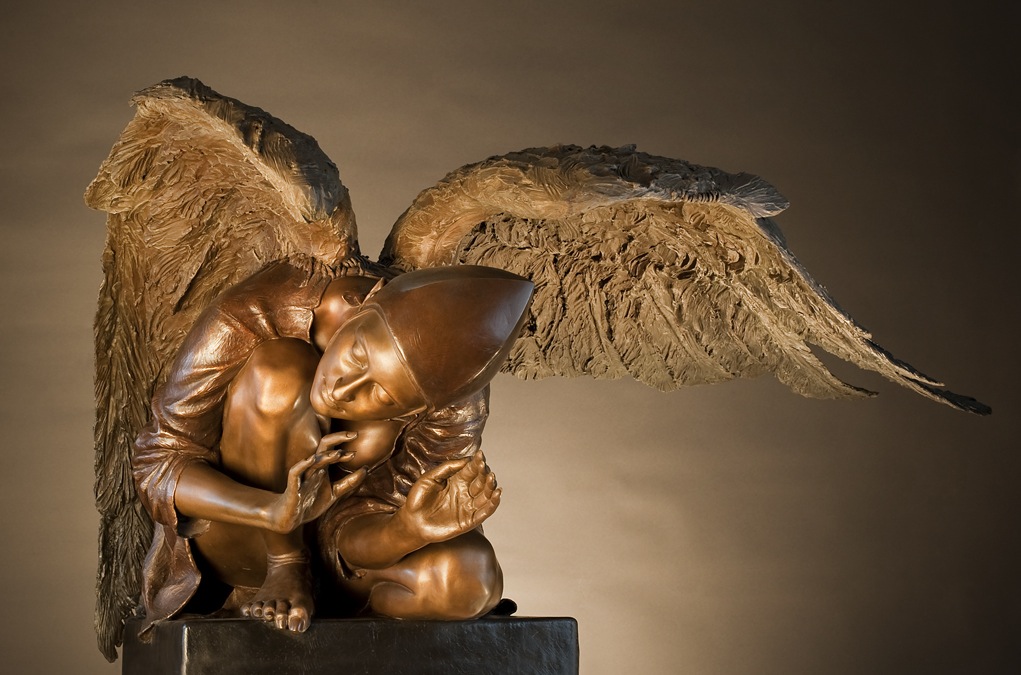
We believe that leaders can learn leadership across disciplines, so we were curious about Kevin Christman’s self leadership practices that create the structure and balance in his independent, creative life.
Ashland, Oregon, our home town is a haven to artists of all types, but one of the very finest is Kevin Christman. Formerly an Engineer with Northrop and McDonnell Douglas, Kevin is a talented sculptor, painter, and stained glass artist.
Topics discussed in this interview
- Leaving the structure of work in corporate settings
- The role of inspiration in creative work
- Time management, self care and balance
- Integrating life and work
Transcript
Sloan:
I’m curious about how you can lead yourself in your daily life work because you don’t have all the structures that most people do.
Christman:
In the beginning that was hard. It was actually really difficult to stop working for somebody else– it was like being untethered, the balloon string cut and you’re floating off. In the beginning that was a disorienting feeling.
I hear from a lot of people that they have to feel the inspiration to work, and they haven’t worked for a while. I’ve learned that that isn’t an effective way for me to work. I start doing something and in the process of doing something I realize the day has gone away and I’ve gotten something done but it wasn’t because there was inspiration there. A lot of times it’s really pulling yourself to get to it and stay on task. Commission work can be a lot of work. The stained glass windows that I did for St. Mary’s took thousands of hours and there was no waiting for inspiration to beckon me into the studio. It was get in the studio, get in early and work late.
I think there’s something to be said about having a child, too. When my son was I was born, I had to get efficient with my time. Time management had to shift. That really helped me in a lot of ways to manage my time differently. Any spare moment I had I would get into the studio. As my time with my son gets less and less and he’s more and more independent, I find I still have those routines of being in the studio and regimenting myself to be there.
Sloan:
In the middle of this unlimited amount of work, how do you take care of your own humanity in the middle of a big commission, a commission that may take a year plus to do? How do you balance out the demands of the work with the requirements of being human?
Christman:
I don’t know if they’re that different. I don’t know if I’m understanding the question. How do I take care of myself within that? It is taking care of myself. Being at the studio or being at work is a certain pleasure and being able to go mountain biking or play a round of golf with my son, those are all meshed together.
The commission I’m finishing up right now is a portrait of the Virgin Mary or St. Mary. I think without having really understood compassion or the love of a child or the feelings that I have experienced raising Jacob, I don’t know if I could have conveyed very clearly a feeling of embrace or of real compassion in her face. Part of my life’s experiences get transferred into what I’m doing. There’s an empathy for life that gets transferred into the artwork. They’re all mixed together. Even in class, there’s a whole human element in there of relationship and understanding and boundaries. It’s a playful territory to understand those things. Then when I’m creating a work of art, I can derive that experience from that and project that into the work and hopefully convey something through the artwork in that way.
Taking care of myself is really playing, being able to have fun, and enjoy life, but I also enjoy working on artwork. There’s a state of bliss–I just really love the act of sculpting or physical painting. When I go out landscape painting after sculpting for a while–I kind of like balancing painting and sculpture back and forth–there’s just the sheer joy of sitting outside, and looking at landscape. It’s sort of meditation, transferring onto a canvas. It really didn’t matter if I sold the painting or not. It was just the experience of sitting out there. I’ve often said a full sketchbook isn’t any good to me. It’s the empty pages that are worth something.
Sloan:
Thinking back to the image of being cutting the string on the balloon, and becoming untethered. But somehow, in that possibly fearful moment, you’ve gained what sounds like integrity. I was making a distinction between work and humanity, and you are talking about how it’s all mixed up, and it’s actually all of one piece. You are living in some kind of a personal integrity where everything is connected.
Christman:
Yeah, I would say that’s true. I think I’ve written that before in different artist statements saying art is life and life is art, it’s all mixed together. I don’t know what people do that don’t have a creative outlet in their lives, or don’t have a way of formulating their experience into some tangible object. If you’re a writer, writing a novel, you’re able to project your experiences into that fictional story. Even though it’s fiction, it’s based on real emotions, a real life lived. Yeah, in my mind it’s all integrated.
Learn more about Kevin
Interesting posts
Conversation as a key leadership skill
